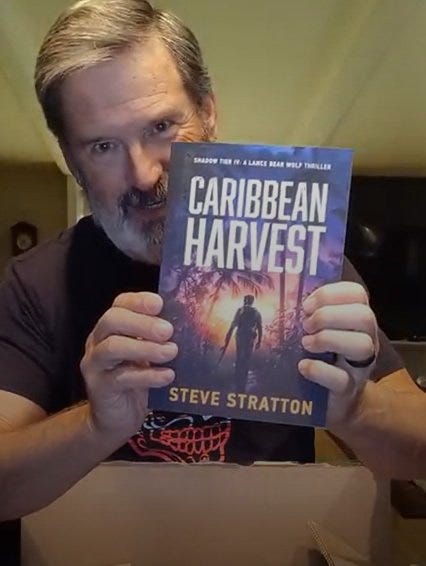What Can Leaders Learn from the Secret Service?
What does it take to effectively build a high-performing team? I had the privilege of speaking with Steve Stratton, an ex-Secret Service professional where he shared his insights on this exact question. From military missions to cybersecurity and writing novels, Steve exemplifies how creativity and connection can lead to remarkable achievements.
🚀 Harnessing Storytelling as a Team-Building Tool
Steve’s self-proclaimed superpower is team building, but not in the conventional sense. For him, the magic lies in storytelling. At first glance, storytelling might seem out of place in a leadership conversation. Yet, Steve makes a compelling argument about its transformative power. He explains that weaving stories helps unite team members, align goals, and foster creative thinking. It’s not about scripted tales, but authentic narratives that inspire and engage.
Storytelling is about connecting dots, and Steve mastered this in high-stakes environments. Leaders who want to build strong teams can explore storytelling in their practices. For some excellent strategies for corporate storytelling, check out Mastering the Art of Storytelling in the Corporate World.
🌲 From the Redwoods to the White House
Steve’s journey began in the redwood forests of Northern California, where teamwork and imagination set the stage for his career. Early exposure to team sports taught him that success isn’t about individual accomplishments but collective wins. This lesson became a cornerstone of his future leadership.
At 19, Steve’s career shifted dramatically when he joined the U.S. military. Originally planning to stay close to home, Steve seized an unexpected opportunity to travel the world. Before he knew it, he was stationed at the White House as a communications specialist, responsible for ensuring secure communication systems. This formative time abroad expanded his worldview and planted seeds for his storytelling leadership style.
🎖 The High-Stakes World of the Secret Service
Steve’s military role evolved into a position with the Secret Service, where technical expertise and leadership converged. Whether working behind the scenes to secure presidential sites or navigating international campaigns, Steve honed his ability to build high-functioning teams under intense pressure.
Key to his leadership philosophy was valuing diverse voices. Steve explains that he avoided hiring “clones” or people who thought just like him. Instead, he looked for individuals with unique perspectives and problem-solving styles. Diverse teams may argue, but they also create richer solutions.
Curious to dive deeper into unique leadership insights? Discover what makes great leaders stand out in Greatest Leader in History: What Can Agile Leaders Learn?.
🔍 Spotting Creativity in Hiring
One of Steve’s leadership superpowers is identifying individual potential. So, how can you spot a team member who’s ready to bring something unique to the table?
Look for Initiative: Steve hired employees who had an ongoing desire to learn—whether earning certifications beyond their role or experimenting in new fields.
Assess Creativity: During interviews, he asked about challenging problems the candidates solved, closely watching for their excitement and approach.
For tips on nurturing creativity within teams, visit Creative Brainstorming and Fun Games to Boost Innovation.
🌐 The Challenges of Global Teams
Steve’s extensive travels, from Europe to South America, brought diversity not only to his teams but to his understanding of leadership. These experiences have underscored the importance of adaptability and cross-cultural understanding.
However, with diversity comes a unique set of challenges. Managing such teams requires empathy and an openness to listening as much as leading. Many of the world’s most innovative leaders thrive by embracing creative methods and perspectives. One powerful way to dive into the concept is through Embrace the Hidden Superpower of Creativity.
🕵️♂️ Lessons from Cybersecurity and Beyond
As a seasoned cybersecurity expert, Steve shifted his focus to threats on a different battlefield: the digital one. He shared the importance of protecting critical infrastructure while stressing that most organisations overlook common-sense measures. Simplifying passwords, enabling two-factor authentication, and monitoring financial activity were among his top recommendations.
Even as technology evolves, Steve believes in people-centred strategies for problem-solving. Leaders, particularly in tech, can’t rely solely on tools. Instead, encouraging critical thinking can safeguard operations.
📚 Transitioning to Writing: Turning Passion into Action
Steve retired from cybersecurity, but by no means did he slow down. Passionate about storytelling, he channelled his experiences into a series of novels. His characters, much like him, are resourceful and inventive. They’re built on encounters he’s witnessed over the years.
This shift is a testament to the power of lifelong learning. Steve embraced his interest in writing later in life, proving it’s never too late to discover a creative outlet. For anyone starting out or considering a new direction, Steve’s advice is to be adaptable and unafraid to pivot. For tips on crafting your ideal role, visit Job Crafting for Peak Performance and Satisfaction.
⚡ What Would Steve Change in Workplaces?
When asked which aspect of work he’d abolish, even temporarily, Steve was quick to respond: the phrase
“we’ve always done it this way.”
To him, this mindset suffocates innovation and progress. Opening the door to flexible, creative problem-solving has been his secret weapon throughout his career.
Final Thoughts
Steve’s journey as a leader, storyteller, and lifelong learner offers practical lessons for anyone looking to enhance their own career. His ability to combine creativity with technical precision has made him a standout leader across multiple domains. Whether you’re building teams, safeguarding your organisation, or finding your next passion project, Steve’s insights remind us to stay curious, adaptable, and bold.
If you’d like to learn even more about creativity, storytelling, or leadership, consider diving into these books:
The Storytelling Animal by Jonathan Gottschall
Leaders Eat Last by Simon Sinek
Creative Confidence by Tom Kelley and David Kelley
Guest: Steve Stratton
Steve Stratton started his military career at the White House Communications Agency supporting the needs of President’s Ford and Carter, Vice President’s Rockefeller and Mondale and Secretary of State Henry Kissinger. His work took him around the world introducing him to new cultures, ways of thinking, and the various agencies tasked with projecting and protecting American interests abroad. The jump to the US Secret Service was an easy transition but after several years and an election campaign, Steve left for the commercial sector.
Steve was awarded his Green Beret in 1986. From the 80’s through 2000 he deployed with 20th Special Forces on counter-drug and training missions in the SOUTHCOM region. His civilian contractor time includes support for USCENTCOM, USSOCOM, and several intelligence agencies. Today he is retired but advising cyber security companies that support the warfighter and intelligence community. When he is not writing, you can find him mountain biking, trout fishing, or hunting in Colorado.
His first novel, Shadow Tier, was named a 2023 Bronze Medal winner by the Military Writers Society of America.
Website: https://www.stevenstrattonusa.com/













